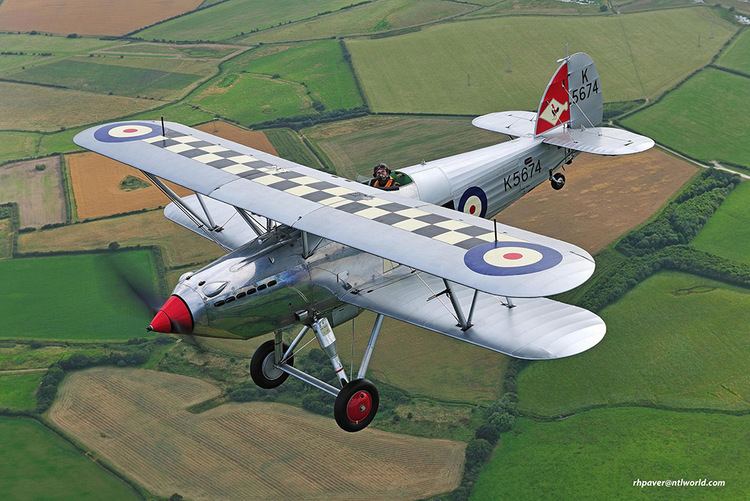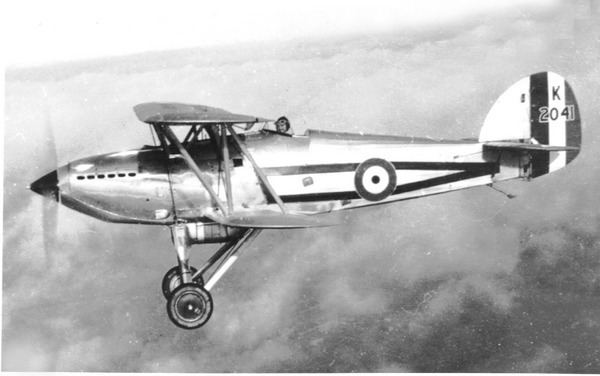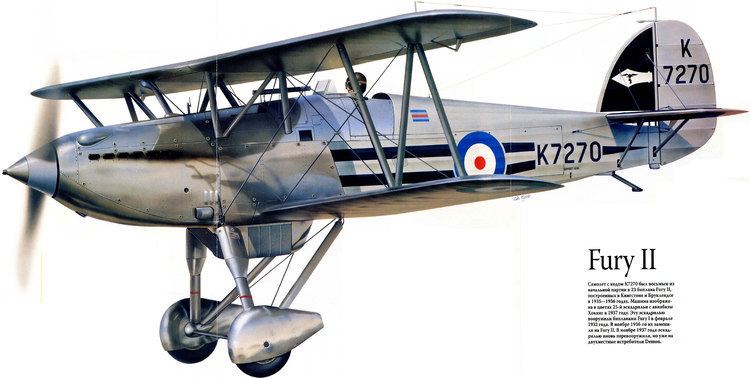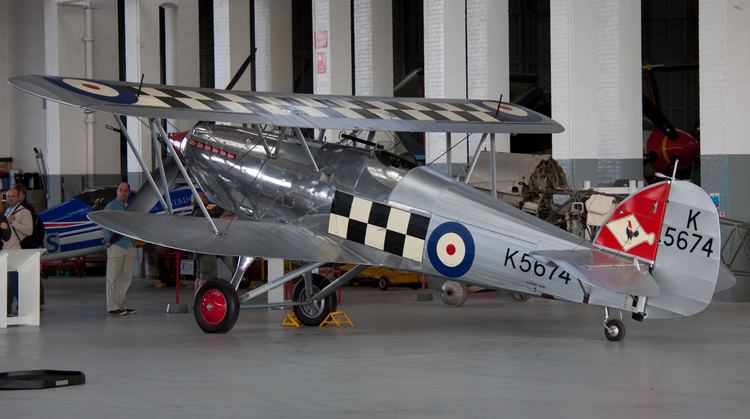Wingspan 9.14 m Introduced 1931 | Length 8.15 m First flight March 25, 1931 Designer Sydney Camm | |
 | ||
Hawker fury mk ii g cbel sr661
The Hawker Fury was a British biplane fighter aircraft used by the Royal Air Force in the 1930s. It was a fast, agile aircraft, and holds the distinction of being the first interceptor in RAF service to be capable of more than 200 MPH. The Fury is the fighter counterpart to the Hawker Hart light bomber.
Contents
- Hawker fury mk ii g cbel sr661
- Design and development
- Operational history
- Variants
- Survivors
- Operators
- Specifications Hawker Fury Mk II
- References

Design and development

The Hawker Fury was a development of the earlier Hawker F.20/27 prototype fighter, replacing the F.20/27's radial engine with the new Rolls-Royce F.XI V-12 engine (later known as the Rolls-Royce Kestrel), which was also used by Hawker's new light bomber, the Hawker Hart. The new fighter prototype, known as the Hawker Hornet, first flew at Brooklands, Surrey, in March 1929. The Hornet was a single-engined biplane, with single bay wings, initially powered by a 420 hp (313 kW) Rolls-Royce F.XIC engine enclosed by a smooth, streamlined cowling, but was quickly re-engined with a 480 hp (358 kW) Kestrel IS. It was evaluated against the similarly powered Fairey Firefly II, being preferred because of its better handling and its all metal structure compared with the mainly wooden construction of the Firefly.

The Hornet was purchased by the Air Ministry at the start of 1930, and was subject to further evaluation, with a small initial production order for 21 aircraft (to be designated Hawker Fury – as the Air Ministry wanted fighter names that "reflected ferocity") placed during 1930. The Fury I made its maiden flight at Brooklands with chief test pilot George Bulman at the controls on 25 March 1931.

The Fury was the RAF's first operational fighter aircraft to be able to exceed 200 mph (322 km/h) in level flight. It had highly sensitive controls which gave it superb aerobatic performance. It was designed partly for the fast interception of bombers and to that end it had a climb rate of almost 2,400 ft/min (730 m/min, powered by a 525 hp/391 kW Kestrel engine).

An experimental prototype, the High Speed Fury, was built to test design features for Hawker's planned competitor for the F.7/30 fighter competition (the Hawker P.V.3) as well as for more general development. While the P.V.3 was unsuccessful owing to the use of the unreliable evaporatively cooled Rolls-Royce Goshawk engine, many of the improvements tested on the High Speed Fury were incorporated in an improved Fury II, with a cleaned up airframe and reduced drag, and powered by a 690 hp (515 kW) Mk4 Kestrel engine. These improvements gave improved speed and rate of climb.

Sidney Camm designed a monoplane version of the Fury in 1933. It was not developed until Rolls-Royce developed what was to become their famous Merlin engine. The design was then revised according to Air Ministry specification F5/34 to become the prototype Hawker Hurricane.
Operational history

The Fury I entered squadron service with the RAF in May 1931, re-equipping No. 43 Squadron. Owing to finance cuts in the Great Depression, only relatively small numbers of Fury Is were ordered, the type equipping 1 and 25 squadrons. At the same time, the slower Bristol Bulldog equipped ten fighter squadrons. The Fury II entered service in 1936–1937, increasing total number of squadrons to six. Furies remained with RAF Fighter Command until January 1939, replaced primarily with Gloster Gladiators and other types, such as Hawker Hurricane. After their front line service ended, they continued to be used for training.

The Fury was exported to several customers, being supplied with a variety of engines, including Kestrels, Hispano Suiza and Lorraine Petrel vee-type engines, Armstrong Siddeley Panther, Pratt & Whitney Hornet and Bristol Mercury radials.
Three Furies were ordered by Spain in 1935, it being intended to produce another 50 under licence. The Spanish variant had a cantilever undercarriage design with Dowty internally sprung wheels, similar to that used on the Gladiator and was powered by a 612 hp (457 kW) Hispano Suiza 12Xbr engine, reaching a speed of 234 mph (377 km/h). The three Furies were delivered without armament on 11 July 1936, just before the outbreak of the Spanish Civil War. They were taken into service by the Spanish Republican Air Force, being fitted with machine guns salvaged from crashed aircraft. One Fury made a forced landing behind enemy lines due to a lack of fuel and was repaired by the Nationalists, although it was not used operationally, while the Republicans used one of the Furies in the defence of Madrid until wrecked in a crash in November 1936.
Although phased out from RAF squadrons, the Fury was still used by some foreign air forces in the early 1940s; Yugoslav Furies saw action against Axis forces in the German invasion of 1941. On 6 April 1941, a squadron of Furies took off to defend their country against the invading German Messerschmitt Bf 109Es and Messerschmitt Bf 110s. In the resulting air battle 10 Furies were destroyed, almost the entire squadron. The commanding officer of the 36 LG was Major Franjo Džal, who watched from the ground as his men were slaughtered in their obsolete biplanes. In an unequal battle against superior adversaries, five aircraft were destroyed while taking off and eight pilots killed. Two more Furies and Bücker Bü 131 were destroyed on the ground. But of the attacking German aircraft, five Bf-109s and two Bf-110s failed to return, though most were non-combat losses, at least one was lost when rammed by a Fury. The other squadron of Yugoslav Furies active at the time of the invasion strafed enemy tanks and ground forces, some being lost to ground fire and one being destroyed in a dogfight with a Fiat CR.42. The rest of the Yugoslav Furies were destroyed when they became unserviceable or at the time of Armistice on the 15th. Ex-RAF Furies were also used by the South African Air Force against the Italian forces in East Africa in 1941 and, despite their obsolescence, destroyed two Caproni bombers as well as strafing many airfields, destroying fighters and bombers on the ground.
A total of 262 Furies were produced, of which 22 served in Persia, 3 in Portugal, at least 30 in South Africa, 3 in Spain, at least 30 in Yugoslavia, and the remainder in the United Kingdom.
Variants
Survivors
A Hawker Fury Mk.I, serial number K5674 , is owned by the Historical Aircraft Collection and based at the Imperial War Museum Duxford in the United Kingdom.
This aircraft was delivered to the RAF in 1935 and allocated to 43 Squadron, where it was flown until 1939 by Flying Officer Frederick Rosier, later to be Air Chief Marshal Sir Frederick Rosier. In 1940, it was sent to South Africa where it was flown by 13 Squadron (later 43 Squadron) of the South African Air Force. It was written-off after making a forced landing, due to running out of fuel.
It was returned to the United Kingdom in 2003 and restored to flying condition, with the civil registration G-CBZP. It made its first post-restoration flight in July 2012.
Hawker fury 1 K1926 being restored at grandsen airfield www. cbfs.org.uk
Operators
Specifications (Hawker Fury Mk II)
Data from The British Fighter since 1912
General characteristics
Performance
Armament
